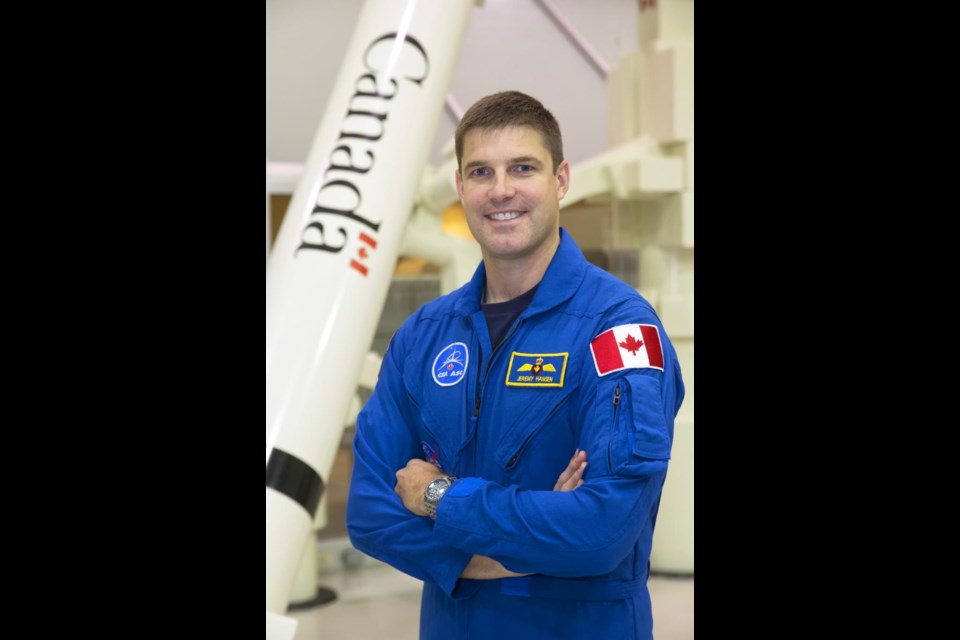Mankind is about to make a second giant leap next year, thanks to the Artemis II program that will see Canadian astronaut Jeremy Hansen catapulted around the moon at 38 times the speed of sound. His mission will prepare the way for future manned missions to earth’s natural satellite.
On the morning of Feb. 9, Hansen made a personal visit to A.E. Peacock Collegiate, which was simultaneously live streamed to a modest crowd at the Moose Jaw Public Library.
Here, Hansen spoke about his upcoming nine-day test mission where the Canadian astronaut will join a crew of NASA astronauts including Christina Hammock Koch, Victor Glover, and Reid Wiseman.
“Thousands of people… realized how we can use space to help Canadians do things like communicate, live better on this planet, (and) create all these solutions…,” he said.
“We (as Canadians) earned our spot here. It’s a huge compliment to Canada, and I’m so proud.”
Hansen also spoke about the value of setting goals and following through, even as – in the case of the multiple early SpaceX Falcon rocket test failures – we may face early adversity.
Hansen was always intrigued by aircraft and recalled borrowing “Encyclopedia A” from the library when he was younger. One day he opened the book on an entry for “(Neil) Armstrong.” This would be his first time learning about space, and he was instantly captivated.
“It blew my mind. What? People went to the moon and came back?” he said. “I got to work right away. I changed my treehouse into a spaceship.”
Born in London, Ont. in 1976, Hansen joined the 614 Royal Canadian Air Cadet Squadron where his first journey into aviation began. At the age of 16 he earned his glider pilot wings, and he later graduated from the Royal Military College of Canada in 1999.
In 2003, Hansen completed his CF-18 Fighter Pilot Training, and served as a fighter pilot until 2009.
He then graduated from Astronaut Candidate Training in 2011, and in 2017 he became the first Canadian to lead a NASA astronaut class. In 2023 Hansen was officially assigned to the Artemis II mission.
“I always had that at the back of my head – I’d like to go to space,” he said.
Now he’s slated to be the first of several Canadians involved in a lunar mission.
The Artemis II mission is the first crewed test flight of the Artemis program, a multi-mission campaign to create a sustained human presence on the moon and prepare for the future exploration of Mars.
Hansen said the space program is valuable because it helps solve problems back here on earth. One of these problems is growing food in Canada’s far north, which has important ties to Indigenous culture.
Kamestastin Lake in northern Labrador is an important place. Viewed as a sacred site, the lake formed when a meteorite impacted with the earth, creating conditions similar to those seen on the moon. Because of this, the CSA uses this site – in collaboration with Indigenous peoples – for training.
“What’s special about it from a scientific point of view is that it has a special rock type called an Anorthosite. It turns out the south pole of the moon is largely formed by Anorthosites,” he explained.
“(The Indigenous people) will train astronauts of the future and make sure we can pick the right rocks for science and understand what we are collecting…”
One highlight of his visit was a four-day vision quest in isolation that impacted him greatly. This Indigenous teaching reflected the isolated conditions Hansen will experience in his upcoming spaceflight.
An Indigenous artist, Henry Guimond of Sagkeeng First Nation in Manitoba, also designed Hansen’s mission badge. Seven animals each bring a unique meaning, and Hansen drew special attention to the beaver.
The beaver, he said, is unique because its continuously growing teeth are used to cut down trees and build dams, thereby helping itself and others to thrive.
“(If) it doesn’t use its gift, its teeth grow and eventually it won’t be able to open its mouth and it will die,” Hansen explained.
“It’s a reminder to us that, in every single person, there is a special gift,” he said. “Your purpose in life is to find that gift, and to contribute it to the world (and) to society to make it better.
“If you don’t use your gift you won’t die, like the beaver. But if you don’t use your gift, you will not be happy, and you will not find your meaning and purpose in life.”
To find that gift, his suggestion was to listen to your mentors. “You’ll know it when you find it, because you will be filled with energy; you’ll want to keep working on whatever it is you’re doing.”
For more information about the Canadian Space Agency or the Artemis II mission, visit asc-csa.gc.ca.
Hansen’s mission to the moon is anticipated to take place no sooner than September 2025.




